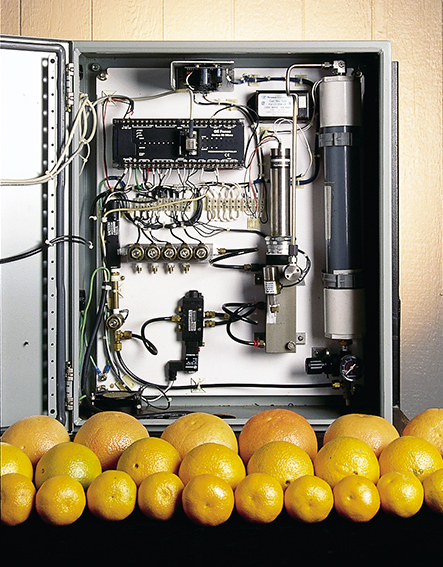Preserving Fresh Fruit
Fresher fruit may soon be arriving on produce stands thanks to research on extending future space missions. NASA's interest in developing a renewable food source for future long-term space travel has led to a new product that will improve the freshness of fruit on Earth.
Geo-Centers, Inc., has developed a patent-pending Ethylene Monitoring and Control System under a combination of a Phase II Small Business Innovation Research (SBIR) contract with NASA's Kennedy Space Center and an internally sponsored Phase III Program. NASA funded the research as part of the Controlled Ecological Life Support Systems (CELSS) breadboard project, with the purpose of monitoring environments in "closed" plant growth chambers.
As plants grow, they produce byproducts of ethylene and ammonia, both of which are harmful to plant development and create stress on the plants at certain concentration levels. A monitoring system is required to control the concentrations in order to optimize the plant growth and maintain the overall health of the plants.
The results of the SBIR research concluded that while an ammonia monitor was feasible for NASA's applications, a vapor phase ethylene monitor would not meet the sensitivity requirements. However, it was determined that the ethylene monitor developed would have applications in the citrus processing market.
Specifically, the ethylene monitor could be used during the de-greening process of citrus fruits; however, finding the proper balance in ethylene concentration is necessary to reduce fruit loss. Proper de-greening requires exposing fruit to ethylene at five parts per million (ppm) for 72 hours. Studies have shown that exposure to ethylene at 15-20 ppm can cause a fruit loss of 50 to 100 percent.
Geo-Centers' ethylene monitor provides an unprecedented measurement range of 0-20 ppm and an accuracy of 0.5 ppm. The monitoring system provides an easy to use, cost effective tool that is capable of continuous monitoring in fruit packing houses. Previous devices were either too expensive, difficult to use, too slow, or did not provide continuous monitoring.
The Ethylene Monitoring and Control System can be installed in a central location and tubes are run to each de-greening room to collect air samples from up to 12 rooms per system. A pumping system draws an air sample from each room and injects it into the sample chamber. Ozone is used in the sample chamber to create a chemiluminescent reaction that produces light. A light detector monitors the level produced, and measures the ethylene concentration against predetermined light levels associated with certain ethylene concentrations. Control signals are then sent to either introduce or stop the flow of more ethylene gas into the room. The entire process takes less than 30 seconds per room.
Currently, Geo-Centers has provided the system to a customer in Europe, as well as two de-greening facilities in the United States, through its distributor, Beshaco, Inc. Geo-Centers hopes to further enhance the sensitivity of the system to make it useful to the larger potential market associated with produce storage applications.

The Ethylene Monitoring and Control System provides optimal exposure of citrus fruit to ethylene, the gas that turns fruit from green to a ripened color.













